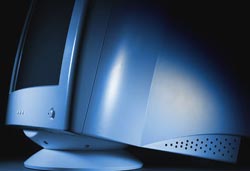 Liquid crystal displays (LCDs) have long been valued over cathode ray tube (CRT) technology due to their slim designs and efficient operation. The final barrier – high costs – is also being addressed, making CRTs fade from the market.
Liquid crystal displays (LCDs) have long been valued over cathode ray tube (CRT) technology due to their slim designs and efficient operation. The final barrier – high costs – is also being addressed, making CRTs fade from the market.
In an effort to produce compact, high-performance computing systems, Apple announced yesterday the discontinuation of its CRT-based eMac computers and the shift to the more affordable iMac systems.
The “Apple” company will equip the iMac with a 17-inch LCD screen that is only 5 cm thick, an 80 GB hard drive, and an Intel Core Duo processor running at 1.83 GHz, priced at $899 for students. The retail version will cost $1,299, featuring a larger hard drive and CD writing capabilities.
As early as 2002, Apple’s CEO Steve Jobs stated, “We are living in a time of rapid development in flat-screen technology. CRT technology is officially dead.” However, it took four more years for Jobs’ prediction to come true at this company famous for its iPod music players.
Apple’s move also clearly reflects the trend of abandoning CRT technology in the computer industry. Five years ago, flat-screen monitors held a modest position in the desktop market, but they have now surpassed CRT technology.
“Consumers can easily purchase CRT monitors for a low price, but fundamentally, they are gradually heading towards ‘extinction’ due to their bulkiness and high power consumption,” commented Tim Bajarin, an analyst at Creative Strategies (USA).
Other competitors of Apple, such as Dell, had previously offered low-cost desktop computers equipped with LCD screens. Although LCDs still carry a higher price than CRTs, many new manufacturing plants in China that have emerged since 2000 are helping to increase output and reduce costs.
P.T.


















































